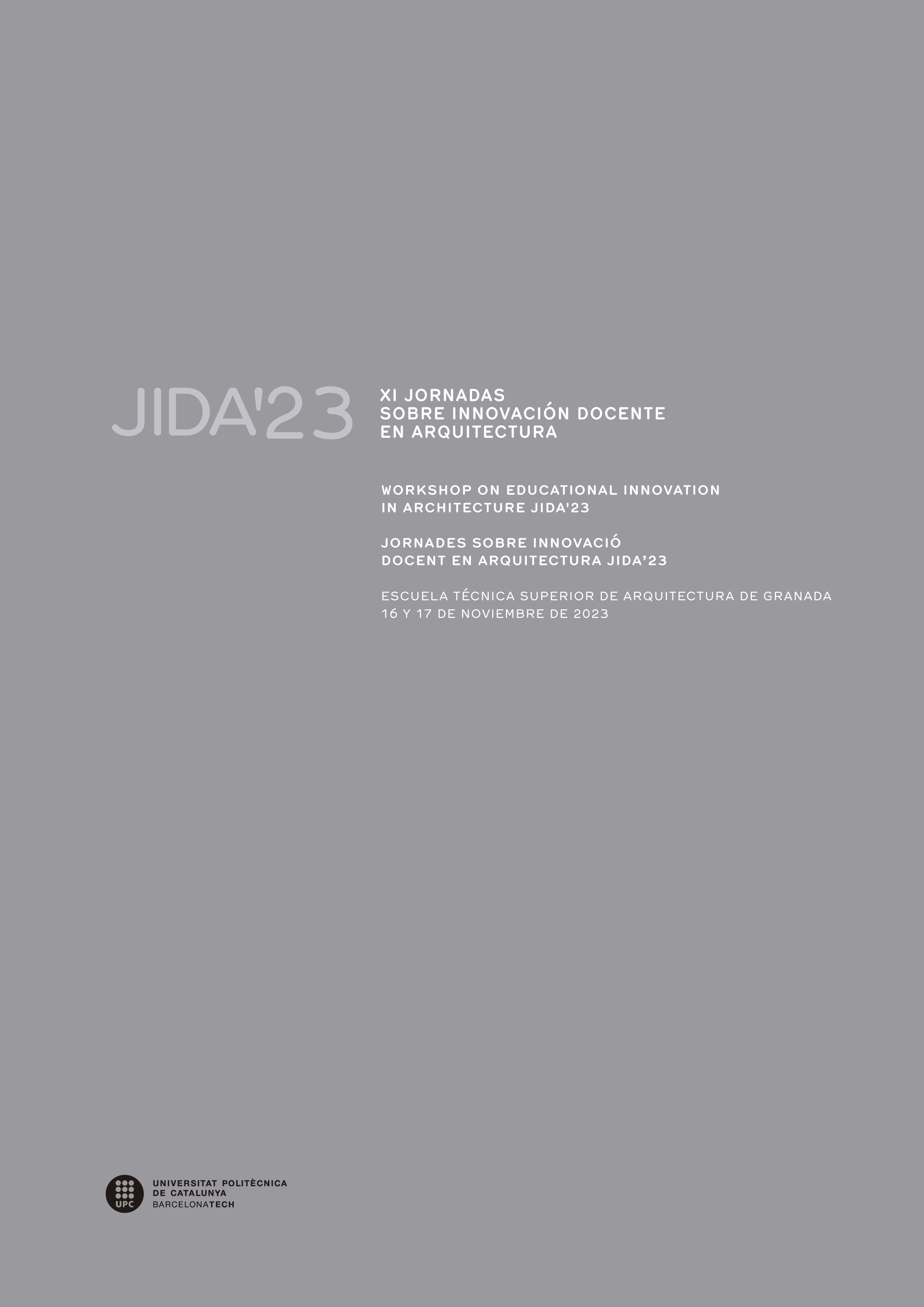Educación Start-up para arquitectos: fomentar soluciones ecológicas innovadoras
DOI:
https://doi.org/10.5821/jida.2023.12350Palabras clave:
educaciónstart-up, aprendizaje práctico, grupos transdisciplinares, educación transfronteriza, innovación ecológicaResumen
Las necesidades y retos del planeta actual siguen evolucionando y cambiando, al igual que el papel del arquitecto. Históricamente, la arquitectura estaba ligada a una disciplina, y hoy en día sigue teniendo un plan de estudios muy estricto. Para abordar los distintos retos, los arquitectos deben trabajar con otras disciplinas y aprender de ellas. Esto debe empezar en la enseñanza superior. Urban Shift, es un programa experimental transnacional diseñado para reunir a estudiantes de distintas disciplinas -arquitectura, medios de comunicación, empresa- y distintos niveles educativos -universidad y formación profesional- para que trabajen juntos en el desarrollo de soluciones de nueva creación. Mediante métodos como el aprendizaje práctico, los estudiantes pueden formar grupos transdisciplinares, identificar un problema, idear una solución, crear prototipos y presentarlos. Como resultado del programa, se desarrollaron siete start-ups que demuestran la necesidad de que la enseñanza de la arquitectura cambie y fomente la innovación.
Citas
Bernstein, J. H. 2015. Transdisciplinarity: A review of its origins, development, and current issues.
Boarin, P. and Martinez-Molina, A. 2022. Integration of environmental sustainability considerations within architectural programmes in higher education: A review of teaching and implementation approaches. Journal of Cleaner Production, 342, p.130989.
Bruce B. C. and Bloch N. 2012. Learning by Doing. In: Seel, N.M. (eds) Encyclopedia of the Sciences of Learning. Springer, Boston, MA. https://doi.org/10.1007/978-1-4419-1428-6_544
Camacho, B. and Alexandre, R. 2019. Design Education. University-industry collaboration, a case study. The Design Journal, 22(sup1), pp.1317-1332. doi: 10.1080/14606925.2019.1594958
Chang J., Benamraoui A. and Rieple A. 2014. Learning-by-doing as an approach to teaching social entrepreneurship. Innovations in education and teaching international, 51(5), 459-471.
Coleman, N. 2010. The Limits of Professional Architectural Education. The International Journal of Art and Design Education, Volume 29, Issue 2, pp. 200-212.
Confluence Institute. n.d. https://www.confluence.eu/en/manifeste/ (Accessed 22 August 2023).
Després, C., Vachon, G. and Fortin, A. 2010. Implementing transdisciplinarity: Architecture and urban planning at work. In Transdisciplinary knowledge production in architecture and urbanism: Towards hybrid modes of inquiry (pp. 33-49). Dordrecht: Springer Netherlands. doi: https://doi.org/10.1007/978-94-007-0104-5_3
Derry S. and Fischer G. 2005. Toward a model and theory for transdisciplinary graduate education. In AERA Annual Meeting, Symposium," Sociotechnical Design for Lifelong Learning: A Crucial Role for Graduate Education", Montreal.
Dezeen. 2016. Architects need to become more entrepreneurial says Odile Decq. Dezeen http://www.dezeen.com/2016/07/20/architects-need-to-become-more-entrepreneurial-says-odile-decq-news-architecture/ (Accessed 22 August 2023).
Farinea C. Villodres R and Guevara M. 2021. Building Urban Intelligent Living Design: Transdisciplinary Education on Nature-Based Solutions. Cumulus Conference Proceedings, 8-11 November, Guayaquil.
Farinea C. and Demeur F. (eds). 2022. BUILD SOLUTIONS CONNECTING BIOLOGY, DESIGN & BUSINESS: Green Thinking to Green Action. Barcelona: Institute for Advanced Architecture of Catalonia.
Karslı U.T. and Özker S. 2014. The contributions of workshops on formal interior architecture education. Procedia-Social and Behavioral Sciences, 152, pp.47-52.
Klein, R. M. 2014. About the 15th Edition of the handbook. In The architect’s handbook of professional practice, ed. R. L. Hayes, xv‒xvii. 15th Edition. Hoboken: John Wiley and Sons.
Lawrence, R., & Després, C. 2004. Futures of transdisciplinarity. In R. J. Lawrence & C. Després
(eds.), Transdisciplinarity in theory and practice. Futures, 36(4 Special issue), 397-405.
Max-Neef M. A. 2005. Foundations of transdisciplinarity. Ecological economics, 53(1), 5-16.
Mayuk S.G. and Coşgun, N. 2020. Learning by Doing in Architecture Education: Building Science Course Example. International Journal of Education in Architecture and Design, 1(1), pp.2-15.
Nikezic A. and Markovic, D., 2013. Learning by Doing as an Architectural Education Teaching Method: Petnica Summer School Case Study. In On Architecture, international conference and exhibition, STRAND (pp. 417-425). Belgrade: STRAND-Sustainable Urban Society Association.
Norman, D. 2010. “Why Design Education Must Change”. In Core 77: Design Magazine and Research. https://www.core77.com/posts/17993/Why-Design-Education-Must-Change (Accessed 22 August 2023)
Rae D and Carswell M (2000) Using a life-story approach in entrepreneurial learning: The development of a conceptual model and its implications in the design of learning experiences. Education and Training, 42, 220-227.
Richardson, N. 2011. Architecture is entrepreneurship and (why) it matters. In Annual ACSA College of Distinguished Professors Annual Conference (pp. 309-313).
Vosloo, C., Vosloo, P. and Antonites, A. 2018. An entrepreneurship education, training and support framework for South African architects. South African Journal of Higher Education, 32(5), pp.289-313.
Wang, T. (2010). “A New Paradigm for Design Studio Education“. International Journal of Art and Design Education, Volume 29, Issue 2, pp.173-183.






















